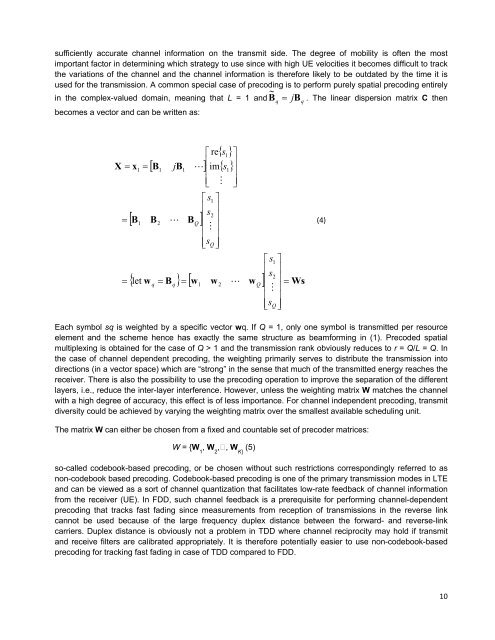MIMO Transmission schemes for LTE and HSPA Networks, 3G
MIMO Transmission schemes for LTE and HSPA Networks, 3G
MIMO Transmission schemes for LTE and HSPA Networks, 3G
- No tags were found...
Create successful ePaper yourself
Turn your PDF publications into a flip-book with our unique Google optimized e-Paper software.
sufficiently accurate channel in<strong>for</strong>mation on the transmit side. The degree of mobility is often the mostimportant factor in determining which strategy to use since with high UE velocities it becomes difficult to trackthe variations of the channel <strong>and</strong> the channel in<strong>for</strong>mation is there<strong>for</strong>e likely to be outdated by the time it isused <strong>for</strong> the transmission. A common special case of precoding is to per<strong>for</strong>m purely spatial precoding entirely~in the complex-valued domain, meaning that L = 1 <strong>and</strong> Bq jBq. The linear dispersion matrix C thenbecomes a vector <strong>and</strong> can be written as:X xB11BBjB reim s1 B s2Q sQs1s ss w B ww w 2let Wsq12q1121Q1 sQ(4)Each symbol sq is weighted by a specific vector wq. If Q = 1, only one symbol is transmitted per resourceelement <strong>and</strong> the scheme hence has exactly the same structure as beam<strong>for</strong>ming in (1). Precoded spatialmultiplexing is obtained <strong>for</strong> the case of Q > 1 <strong>and</strong> the transmission rank obviously reduces to r = Q/L = Q. Inthe case of channel dependent precoding, the weighting primarily serves to distribute the transmission intodirections (in a vector space) which are “strong” in the sense that much of the transmitted energy reaches thereceiver. There is also the possibility to use the precoding operation to improve the separation of the differentlayers, i.e., reduce the inter-layer interference. However, unless the weighting matrix W matches the channelwith a high degree of accuracy, this effect is of less importance. For channel independent precoding, transmitdiversity could be achieved by varying the weighting matrix over the smallest available scheduling unit.The matrix W can either be chosen from a fixed <strong>and</strong> countable set of precoder matrices:W = {W 1, W 2,, W K}(5)so-called codebook-based precoding, or be chosen without such restrictions correspondingly referred to asnon-codebook based precoding. Codebook-based precoding is one of the primary transmission modes in <strong>LTE</strong><strong>and</strong> can be viewed as a sort of channel quantization that facilitates low-rate feedback of channel in<strong>for</strong>mationfrom the receiver (UE). In FDD, such channel feedback is a prerequisite <strong>for</strong> per<strong>for</strong>ming channel-dependentprecoding that tracks fast fading since measurements from reception of transmissions in the reverse linkcannot be used because of the large frequency duplex distance between the <strong>for</strong>ward- <strong>and</strong> reverse-linkcarriers. Duplex distance is obviously not a problem in TDD where channel reciprocity may hold if transmit<strong>and</strong> receive filters are calibrated appropriately. It is there<strong>for</strong>e potentially easier to use non-codebook-basedprecoding <strong>for</strong> tracking fast fading in case of TDD compared to FDD.10
















